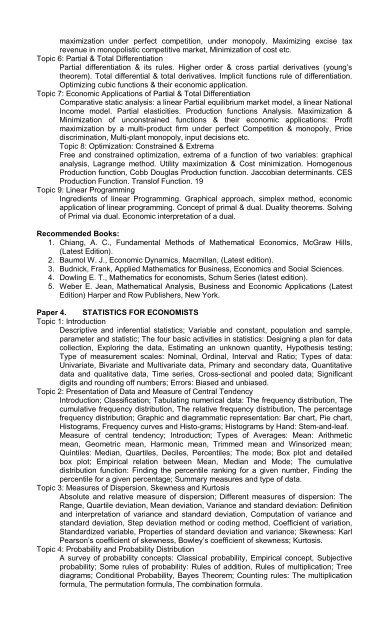MA_Economics_Annual_System
Create successful ePaper yourself
Turn your PDF publications into a flip-book with our unique Google optimized e-Paper software.
maximization under perfect competition, under monopoly. Maximizing excise tax<br />
revenue in monopolistic competitive market, Minimization of cost etc.<br />
Topic 6: Partial & Total Differentiation<br />
Partial differentiation & its rules. Higher order & cross partial derivatives (young’s<br />
theorem). Total differential & total derivatives. Implicit functions rule of differentiation.<br />
Optimizing cubic functions & their economic application.<br />
Topic 7: Economic Applications of Partial & Total Differentiation<br />
Comparative static analysis: a linear Partial equilibrium market model, a linear National<br />
Income model. Partial elasticities. Production functions Analysis. Maximization &<br />
Minimization of unconstrained functions & their economic applications: Profit<br />
maximization by a multi-product firm under perfect Competition & monopoly, Price<br />
discrimination, Multi-plant monopoly, input decisions etc.<br />
Topic 8: Optimization: Constrained & Extrema<br />
Free and constrained optimization, extrema of a function of two variables: graphical<br />
analysis, Lagrange method. Utility maximization & Cost minimization. Homogenous<br />
Production function, Cobb Douglas Production function. Jaccobian determinants. CES<br />
Production Function. Translof Function. 19<br />
Topic 9: Linear Programming<br />
Ingredients of linear Programming. Graphical approach, simplex method, economic<br />
application of linear programming. Concept of primal & dual. Duality theorems. Solving<br />
of Primal via dual. Economic interpretation of a dual.<br />
Recommended Books:<br />
1. Chiang, A. C., Fundamental Methods of Mathematical <strong>Economics</strong>, McGraw Hills,<br />
(Latest Edition).<br />
2. Baumol W. J., Economic Dynamics, Macmillan, (Latest edition).<br />
3. Budnick, Frank, Applied Mathematics for Business, <strong>Economics</strong> and Social Sciences.<br />
4. Dowling E. T., Mathematics for economists, Schum Series (latest edition).<br />
5. Weber E. Jean, Mathematical Analysis, Business and Economic Applications (Latest<br />
Edition) Harper and Row Publishers, New York.<br />
Paper 4. STATISTICS FOR ECONOMISTS<br />
Topic 1: Introduction<br />
Descriptive and inferential statistics; Variable and constant, population and sample,<br />
parameter and statistic; The four basic activities in statistics: Designing a plan for data<br />
collection, Exploring the data, Estimating an unknown quantity, Hypothesis testing;<br />
Type of measurement scales: Nominal, Ordinal, Interval and Ratio; Types of data:<br />
Univariate, Bivariate and Multivariate data, Primary and secondary data, Quantitative<br />
data and qualitative data, Time series, Cross-sectional and pooled data; Significant<br />
digits and rounding off numbers; Errors: Biased and unbiased.<br />
Topic 2: Presentation of Data and Measure of Central Tendency<br />
Introduction; Classification; Tabulating numerical data: The frequency distribution, The<br />
cumulative frequency distribution, The relative frequency distribution, The percentage<br />
frequency distribution; Graphic and diagrammatic representation: Bar chart, Pie chart,<br />
Histograms, Frequency curves and Histo-grams; Histograms by Hand: Stem-and-leaf.<br />
Measure of central tendency; Introduction; Types of Averages: Mean: Arithmetic<br />
mean, Geometric mean, Harmonic mean, Trimmed mean and Winsorized mean;<br />
Quintiles: Median, Quartiles, Deciles, Percentiles; The mode; Box plot and detailed<br />
box plot; Empirical relation between Mean, Median and Mode; The cumulative<br />
distribution function: Finding the percentile ranking for a given number, Finding the<br />
percentile for a given percentage; Summary measures and type of data.<br />
Topic 3: Measures of Dispersion, Skewness and Kurtosis<br />
Absolute and relative measure of dispersion; Different measures of dispersion: The<br />
Range, Quartile deviation, Mean deviation, Variance and standard deviation: Definition<br />
and interpretation of variance and standard deviation, Computation of variance and<br />
standard deviation, Step deviation method or coding method, Coefficient of variation,<br />
Standardized variable, Properties of standard deviation and variance; Skewness: Karl<br />
Pearson’s coefficient of skewness, Bowley’s coefficient of skewness; Kurtosis.<br />
Topic 4: Probability and Probability Distribution<br />
A survey of probability concepts: Classical probability, Empirical concept, Subjective<br />
probability; Some rules of probability: Rules of addition, Rules of multiplication; Tree<br />
diagrams; Conditional Probability, Bayes Theorem; Counting rules: The multiplication<br />
formula, The permutation formula, The combination formula.



